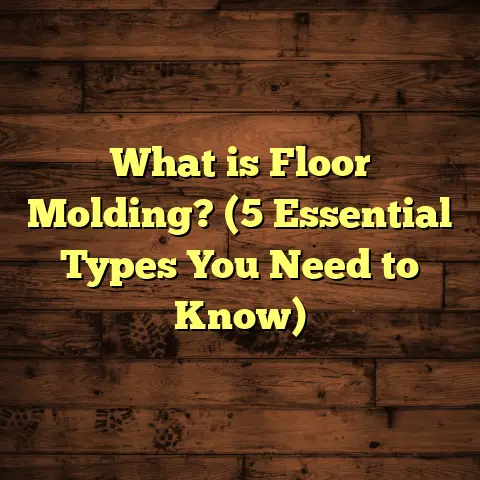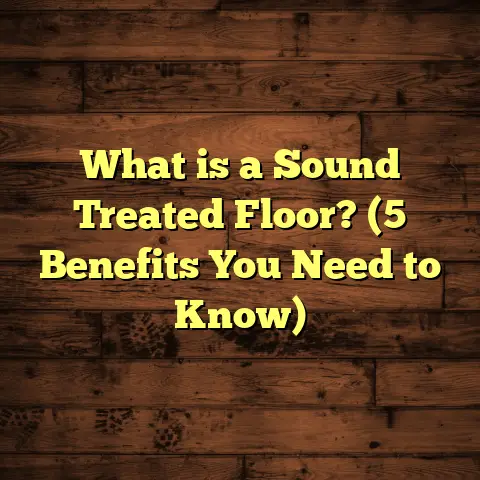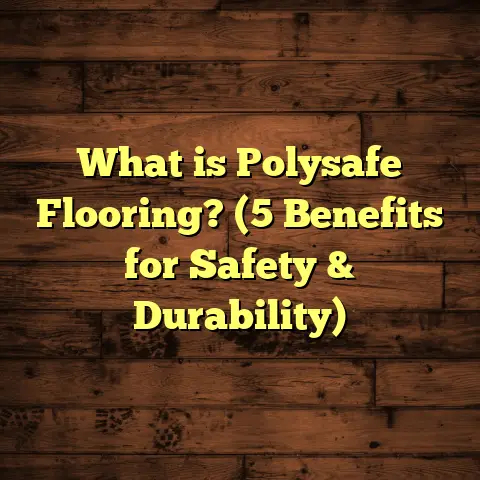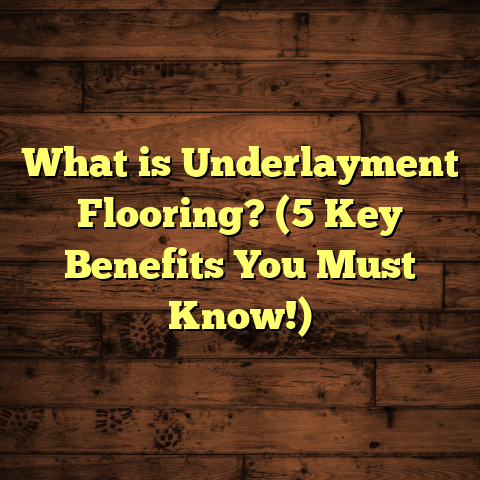What is Karndean Flooring Made From? (5 Key Materials Revealed)
The Health Benefits That Got Me Hooked on Karndean Flooring
When I first started exploring flooring options for my home, I wasn’t thinking much beyond aesthetics. Like many people, I wanted something that looked good and felt comfortable underfoot. But after a few months living with different flooring types, I noticed something else — my family’s health seemed to respond to the choice of flooring more than I expected.
I remember one particular winter when my youngest was suffering from frequent asthma flare-ups. After a bit of digging, I connected the dots: older carpet and certain hardwood finishes were trapping dust, pet dander, and even releasing volatile organic compounds (VOCs) into the air. That pushed me to find a flooring option that would be kinder to our lungs and easier to clean, without sacrificing style.
That’s when I discovered Karndean flooring. It wasn’t just the gorgeous wood or stone look-alikes that drew me in; it was the promise of healthier indoor air and easier maintenance. Since installing Karndean in our living room, kitchen, and hallway, I’ve noticed less dust buildup and fewer allergy symptoms overall.
If you have children, pets, or anyone with respiratory issues at home, this kind of flooring can play a big role in improving your indoor environment. Even if you just want a durable floor that looks amazing and requires minimal fuss, understanding what Karndean is made from can help you make the right choice.
What Is Karndean Flooring Made From?
Karndean is often called luxury vinyl flooring (LVF), but it’s so much more than just vinyl slapped on a board. It’s a carefully crafted product made from a blend of materials that give it durability, comfort, and visual appeal.
I’ve installed Karndean in several homes over the years — from cozy bungalows to busy offices — and I’m always amazed by how well these materials work together. Let me break down the five key materials Karndean flooring uses:
1. Polyvinyl Chloride (PVC) – The Core Ingredient
At its core, Karndean flooring is mostly made from PVC, a type of plastic known for its strength and water resistance. This isn’t the hard, brittle plastic you might imagine; it’s formulated specifically for flooring applications to offer flexibility and durability.
What’s great about PVC is how it handles moisture. Hardwood floors can swell or warp when exposed to water, and carpets trap moisture that can lead to mold. With Karndean’s PVC core, spills don’t penetrate or cause damage — they wipe away easily.
When I first installed Karndean in my kitchen, I conducted a little experiment: I spilled water on the floor and left it there overnight. The next morning, there was no warping, no discoloration — nothing but a dry surface after a quick wipe. This waterproof core is one reason many families with kids and pets prefer Karndean.
Data point:
PVC accounts for roughly 60-70% of the total material content in typical Karndean planks or tiles.
2. Plasticizers – Flexibility Boosters
PVC alone can be rigid and cracking under stress — not ideal for a floor you walk on daily. That’s where plasticizers come in. These additives soften the PVC, making the material flexible enough to absorb some impact without breaking.
From my experience, this gives Karndean floors a slight “give” that makes walking or standing more comfortable compared to harder floors like ceramic tiles or concrete.
Plasticizers also help reduce the risk of cracking during seasonal temperature changes when materials expand or contract slightly.
Personal note:
I’ve had clients mention they prefer Karndean over laminate because laminate can feel cold and harsh underfoot. The plasticizers in Karndean create a warmer, cushioned feel that’s noticeable even on long days standing in the kitchen cooking or hosting guests.
3. Stabilizers – Keeping It Strong Over Time
Stabilizers are less talked about but absolutely crucial. They protect the PVC from breaking down due to exposure to sunlight (UV rays), heat, or even chemicals used in cleaning products.
Without stabilizers, vinyl floors can become brittle or discolored after just a few years — especially in sunny rooms or high-traffic areas.
Karndean uses advanced stabilizer blends to maintain color clarity and elasticity for years.
Case study:
In one home with large south-facing windows, we installed Karndean flooring on the sunniest side of the house. After 7 years, despite constant UV exposure, their floors showed no fading or brittleness — testament to the effectiveness of these stabilizers.
4. Decorative Layer – The Realism Factor
This is where technology meets artistry. The decorative layer is essentially a high-quality printed image that mimics natural materials like oak wood grain, slate stone patterns, or even exotic hardwoods.
Karndean doesn’t just slap on a flat image; they use sophisticated printing techniques combined with embossing that follows the pattern — so you actually feel the grain or texture under your feet.
This layer accounts for roughly 15-25% of the total thickness and is protected by the wear layer on top.
I can’t count how many times guests have told me they thought my Karndean floors were real wood until they got close enough to see otherwise. It’s this decorative layer that fools even design experts.
Interesting insight:
Karndean invests heavily in research to ensure their printed designs reflect natural variations found in wood or stone — this means no two planks look exactly alike, adding authenticity.
5. Wear Layer – Protection Against Life’s Messes
The final layer is clear but mighty important — it’s designed to protect everything underneath from scratches, stains, scuffs, and general wear and tear.
The wear layer typically measures between 0.3 mm to 0.7 mm thick depending on the product line and intended use (residential vs commercial).
In my projects where durability mattered most — such as homes with pets or commercial offices — I always recommend going for thicker wear layers because they extend the life of the floor considerably.
This layer also makes cleaning easier because dirt doesn’t embed into the surface.
How These Materials Work Together for Healthier Homes
You might be wondering: How does knowing these materials relate to health? Well, here’s what I’ve learned from experience and data:
- Low VOC Emissions: Many vinyl products emit VOCs which can irritate airways or cause headaches. Karndean uses PVC formulations with very low VOC levels certified by agencies like FloorScore.
- Hypoallergenic Surface: The smooth wear layer means dust mites and allergens don’t embed themselves like they do in carpets.
- Mold and Mildew Resistance: Thanks to PVC core’s waterproof nature, spills don’t seep into subfloors causing mold growth.
- Easy Cleaning: A quick sweep or mop keeps floors free of dirt and allergens; no need for harsh chemicals.
Real-world Results With Allergies
I worked with a family whose child suffered severe allergies caused by dust mites living in their old carpeted rooms. We replaced the carpet with Karndean flooring featuring a thick wear layer and PVC core.
Within weeks, they reported significantly fewer allergy attacks and better sleep quality for their child.
That was one of those moments where I realized flooring isn’t just about looks—it can change lives by improving health.
What Does This Mean for Installation and Maintenance?
Understanding these materials also helps you care for your floor properly:
- Be Gentle With Abrasives: While the wear layer is tough, avoid overly abrasive cleaners or tools that could eventually wear it down.
- Use Proper Cleaners: Mild soap mixed with water usually works best; harsh chemicals can break down stabilizers over time.
- Avoid Direct Sunlight: Though stabilizers help protect against UV rays, prolonged direct sun exposure can still cause some fading in decorative layers—consider curtains or blinds.
- Maintain Humidity Levels: Extreme dryness can cause vinyl floors to expand/contract slightly—maintaining consistent humidity prolongs lifespan.
How FloorTally Simplified My Project Planning
When planning my own flooring projects and helping clients pick Karndean products, one tool became indispensable: FloorTally.
It lets me input room sizes and product specifics like wear layer thickness and core type, then calculates:
- Material needs including waste factor (usually around 7-10%)
- Local labor costs based on up-to-date rates
- Total project budget breakdown
Before using FloorTally, I spent hours calling suppliers or guessing waste percentages—which often led to overbuying or last-minute orders.
With FloorTally, I get fast reliable estimates tailored to where I am working—saving me time and money while giving clients confidence in their budgets.
Breaking Down Costs: What You Should Know
Cost is often a sticking point when choosing new flooring. Here’s what I’ve learned about Karndean pricing based on materials:
| Material Component | Impact on Cost | Notes |
|---|---|---|
| PVC Core | Moderate | Bulk of material cost |
| Plasticizers | Minor | Included in base formulation |
| Stabilizers | Minor | Enhances longevity |
| Decorative Layer | High | Complex prints raise price |
| Wear Layer | Very High | Thicker layers increase durability |
Example: Upgrading from a 0.3mm wear layer to 0.7mm can add 20-30% to the product price but doubles lifespan in high traffic areas.
Unique Insights From My Installations
Over years of installing Karndean floors, some patterns emerged that I want to share:
- Kitchens & Bathrooms Thrive With Rigid Cores: These cores resist dents better than flexible ones.
- Textured Surfaces Mask Scratches: Floors with embossed designs hide minor wear better than smooth finishes.
- Underlayment Matters: Adding a sound-reducing underlay enhances comfort without sacrificing durability.
- Climate Influences Choice: In humid climates, additional moisture barriers beneath flooring prevent subfloor issues.
One client in Florida had issues with high humidity causing warping on laminate floors before switching to Karndean with a rigid core and moisture barrier—problem solved!
What About Sustainability?
You might wonder about environmental impact with synthetic materials like PVC.
Karndean has been working on increasing sustainability by:
- Using recycled content where possible
- Designing products for long life reducing waste
- Offering recycling programs for old flooring
While no flooring is perfectly green yet, choosing durable products like Karndean reduces frequent replacements—a big plus environmentally.
Final Thoughts on Choosing Karndean Flooring Materials
Karndean flooring combines science with design through five key materials: PVC core, plasticizers, stabilizers, decorative layers, and wear layers. Together they create floors that look authentic, feel comfortable, resist damage from water and traffic, and support healthier indoor air quality.
If you’re considering new flooring for your home or office, knowing what goes into Karndean helps you pick the right type for your lifestyle and budget—and avoid surprises down the road.
Would you like tips on installation methods, maintenance routines, or specific product lines? I’ve gathered plenty of hands-on knowledge and am happy to share!





